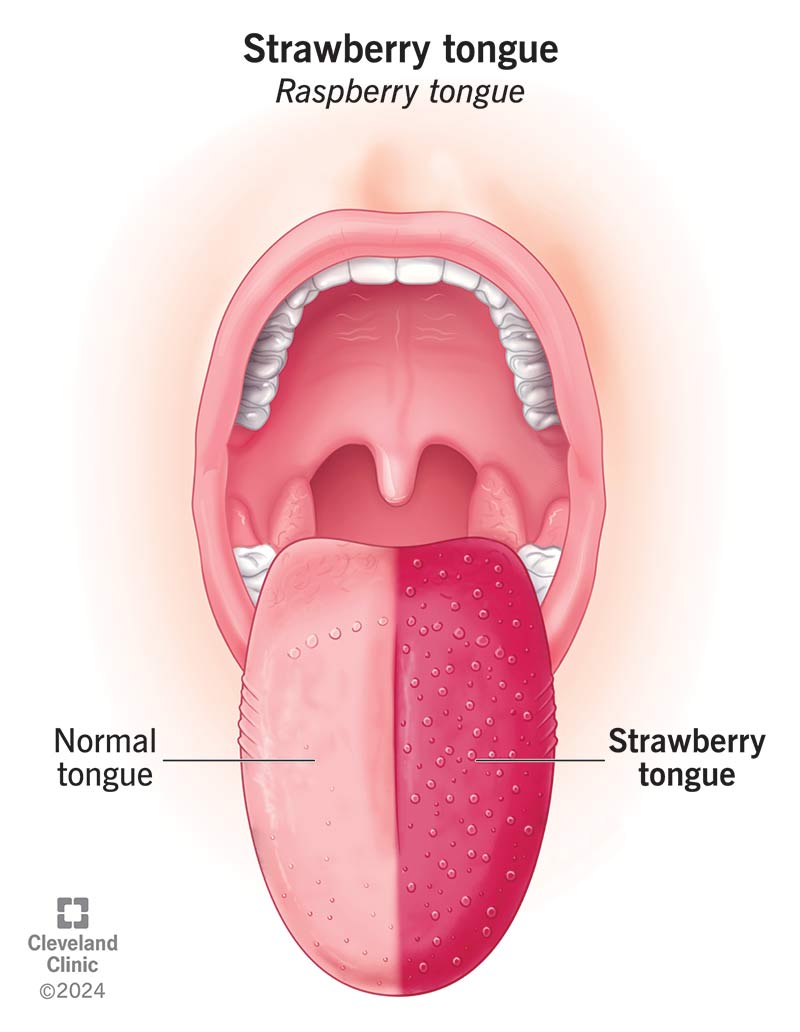A strawberry tongue involves having a tongue that’s red with large bumps that look like the skin of a strawberry. It’s usually a sign of scarlet fever, toxic shock syndrome or Kawasaki disease. A strawberry tongue goes away once a healthcare provider treats the condition that caused it.
Advertisement
Cleveland Clinic is a non-profit academic medical center. Advertising on our site helps support our mission. We do not endorse non-Cleveland Clinic products or services. Policy

A strawberry tongue is an uncommon symptom that changes your tongue’s appearance. Healthy tongues are typically pink with tiny bumps. But a strawberry tongue is bright red with enlarged bumps that resemble seeds on strawberry skin. Some people think the bumps and the color look more like raspberries. This is why some people call strawberry tongue “raspberry tongue” instead.
Advertisement
Cleveland Clinic is a non-profit academic medical center. Advertising on our site helps support our mission. We do not endorse non-Cleveland Clinic products or services. Policy
Most of us think of strawberries (and raspberries) as delicious, warm-weather treats, but having a strawberry tongue isn’t so good. The most common conditions that cause strawberry tongue are treatable — but can be serious without it.
You’ll need to see a healthcare provider to determine whether the redness and bumps are a sign of something serious.
Scarlet fever, toxic shock syndrome (TSS) and Kawasaki disease are the most common causes of strawberry tongue.
In extremely rare instances, strawberry tongue may be a sign of:
Scarlet fever is a bacterial infection caused by group A Streptococcus — the same bacteria that cause strep throat. Anyone can get this infection, but it’s most common in children ages 5 to 15.
Unlike strep throat alone, with scarlet fever, the bacteria release a poison responsible for the uniquely red (scarlet) symptoms — like a strawberry tongue. If you have an infection, your tongue may start out white. This is called “white strawberry tongue.” But within a few days, it turns bright red.
Your provider may suspect scarlet fever if they notice symptoms in addition to a strawberry tongue, like:
Advertisement
A strawberry tongue is one potential sign of toxic shock syndrome (TSS). TSS is a rare condition most often caused by infections from Staphylococcus and group A Streptococcus bacteria. Most people think of TSS as an infection you can get from leaving a tampon in for too long. But anyone can get it if the bacteria grow out of control and start to produce toxins (poisons).
Signs and symptoms of TSS usually develop fast, within 48 hours. Symptoms other than a strawberry tongue include:
A strawberry tongue may be a sign your child has a rare condition called Kawasaki disease. This condition causes inflammation that can damage your child’s blood vessels if it’s left untreated. It’s unclear what causes it, but it’s most common in children 6 months to 5 years old.
Your healthcare provider will act fast to determine whether your child’s strawberry tongue is a sign of Kawasaki disease, so they can treat it immediately.
Symptoms of this condition besides a strawberry tongue include:
Your strawberry tongue will go away once you get treatment for the condition that caused it. Treatments may include:
Advertisement
Most causes of strawberry tongue don’t lead to complications. Healthcare providers usually treat the underlying condition before there’s an issue.
But skipping treatment altogether can pose serious health risks.
For example, untreated Kawasaki disease can damage the arteries that supply blood to your child’s heart (coronary arteries). This can cause serious heart problems. Without treatment, the bacterial infections that cause scarlet fever and TSS can spread, causing organ damage.
There’s no need to panic about these worst-case scenarios if you or your child has a strawberry tongue. Still, take these tongue changes seriously enough to have your healthcare provider take a look.
Always contact a healthcare provider if you suspect you or your child has strawberry tongue. Most conditions that cause this symptom won’t just go away on their own, and they can get worse without treatment. It’s important to get checked.
It’s easy to mistake glossitis for a strawberry tongue. Glossitis is tongue inflammation that causes redness and swelling. Like strawberry tongue, you can develop glossitis from causes like infections, allergies and nutritional deficiencies.
But with glossitis, your tongue usually looks smooth and even glossy, not bumpy. Glossitis has more potential causes than strawberry tongue. With strawberry tongue, providers usually think of scarlet fever first, or (less commonly) toxic shock syndrome or Kawasaki disease.
Advertisement
A tongue that looks like a ripened strawberry or raspberry isn’t something to worry about. Still, it’s something your provider needs to check. Often, the issue is a bacterial infection that a course of antibiotics can take care of. Schedule an appointment to have a provider check your or your child’s tongue if it’s strawberry red.
Advertisement
Last reviewed on 07/11/2024.
Learn more about the Health Library and our editorial process.